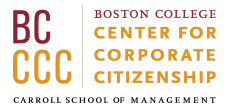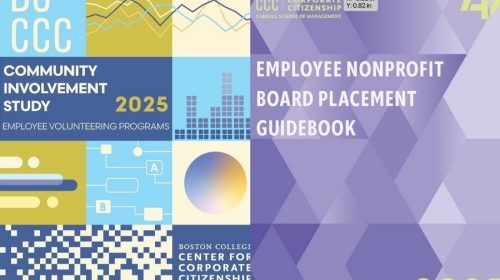WEBINAR: This webinar explores how to measure and communicate your organization's social impact with proven frameworks and strategies that matter to stakeholders.
People + Purpose = Progress

A couple of years ago, we convened at our annual conference in Dallas to learn about how to improve our practice of corporate citizenship. A lot has changed in the intervening months and we look forward to when we will be able to be with you again in person. Reflecting on our discussion then of how corporate citizenship deepens employee engagement and productivity may seem like a moot conversation during a period of high unemployment and economic uncertainty, but I believe this work is more relevant than ever.
In a time when you may be moving towards smaller teams and many are forced to work remotely, corporate citizenship can provide important reinforcement of organizational values and provide opportunities for engagement and group cohesiveness that deepens the commitment of your employees to the company.
All of the people working in corporate citizenship are united by a common purpose, which is to create more good in the world. We want to create not only the world in which we want do business, but also the world in which we want to live. Sharing your mission with other employees can connect them in a deeper way to the purpose of your company, thereby creating more meaning and connection in their work. There are lots of resources that the Boston College Center for Corporate Citizenship offers to help you to do that.
I just want to take a minute and talk about the purpose of the Boston College Center for Corporate Citizenship. It's our great privilege as an organization to help people in companies think about how they make better choices about environmental and social investments. We do that in a variety of different ways, from our online resource library to our online community, where you can ask a question which will be answered by people from other companies or the team from the Center. We publish research and other useful tools, including a weekly Media Monitor that helps you keep track of the trends that are coming up in your practice. We have member knowledge requests, so if you're curious about how some of these issues might be impacting your industry or your company directly, you can call us and we'll put the resources together for you. Of course, we have networking events, from our annual Conference to Member Meetups held monthly. We also offer courses in a variety of formats, from short live Bootcamps to self-paced and online options. You can combine both of these formats at the Accelerated Certificate Summit, which is another great networking opportunity.
Almost all companies are now committed to community involvement. When that used to be a “nice to have” 10 years ago when I started at the Center, it is now a core part of business. Findings from the Center’s most recent Community Involvement Study indicate that nearly all companies are actually approaching community involvement as something that they have to do, and that they want to do.
Companies also continue to get more strategic about the causes that they choose. Now 92% of companies say that they are choosing causes that are aligned to their business operations. It used to be that companies might feel if they were doing something that was strategic to the business, it was uncharitable. Now, companies have come to realize that their strategically aligned programs tend to be viewed as more credible. We see companies investing more strategically and for the longer term. There's increased sophistication from the business side and the social side.
Employees are an important audience for community involvement programs. We've seen this as a trend that has intensified over the last couple of studies. One of the things we ask the companies that participate in this study is: Do you measure the correlation between engagement and participation in community involvement? What we see is that 63% of companies are measuring the connection between engagement and participation.
Of those 63% who are measuring, a whopping 95% of them see improved engagement among those employees who are participating in community involvement. That's hugely powerful and important. It's a real value that you as corporate citizenship professionals bring to your company. If you haven't yet figured out how to connect your retention to your participation—it's possible. The Center can help you figure out the process for that, or you may learn from colleagues in the online community, Member Meetups, or other networking opportunities we provide.
The Business Case for Employee Engagement: A Closer Look
So we see that participation leads to engagement. Why is engagement important to us as corporate citizenship professionals? It's because engagement improves performance.

Gallup has done a lot of work on this, and here is a very topline recap of their most recent State of the American Workplace study1. We know that the bottom quartile of engagement is not going to perform as well as the top quartile. If we compare the top quartile to the bottom quartile, we see that the top quartile has 59% lower turnover (even in low-turnover organizations), 41% lower absenteeism, 17% higher productivity, 20% higher sales, and 21% profitability. Now, this data come from a data analysis across 200 different studies that span 34 countries, so this is pretty well substantiated. But we can clearly see that engagement leads to better performance.
Not only do we need to have high-performing people in our company staying in our company, we need to be able to attract great people to our companies. It turns out that this is going to be a huge issue for competitiveness in the coming decade, and we're already seeing some real indications of that.

In an ideal universe we have one person for one job. That's a perfectly balanced labor economy. As of pre-recession, we actually had, on average, more than one person for one job, so we had labor slack. Companies were in a pretty good position; if they had a job open they would have lots of candidates from which to choose. Post-recession, we see that that labor market starts to tighten. Of course, the knowledge-based companies are the ones that are most challenged in this situation. Retail and construction, not so much. In 2017, which is the most recently available data from the National Bureau of Labor Statistics, you can see that across the board, there are not enough employees to be able to fill the jobs that are available.2 Some industries such as finance and insurance, IT and technology, and healthcare, are really challenged. Finance and insurance is only able to fill approximately 45% of vacancies. The average turnover in companies is 19% across the board in the U.S. So this is a significant problem for companies.

Let's look at the value of retention and recruiting. Say a company has 1,000 employees, and each is making an average salary of $70,000 per year. Each worker is expected to produce productivity of at least their salary, by a very conservative estimate. The average, really, is approximately three times the value of salary in the U.S. So you have productivity of $140 million per year based on that calculation. You also have an expense of $70 million a year from salaries. So, your net productivity would be $70 million.
We have vacancies of 19%, which is the U.S. average, which means that we get salary savings back of $6 million. But we also have a productivity cost, in which we've lost people so we're not able to get productivity from them. You have the turnover, which is 19% plus the vacancy rate; for this illustration we're using the highest vacancy rate of 45%, in which you have a $12 million loss in productivity. Then you have the cost to fill and cover those vacancies, which is $2.6 million, conservatively. Add the onboarding and orientation costs of bringing new employees on; let's just say that's $1 million.
So you have gone from productivity of $70 million expected, if you are purely efficient, to productivity of $60,500,000. Which means that you have productivity loss of 16%. That's significant. Now, if you are able to reduce turnover and vacancy by 2%, you can save almost $2 million. And if you're able to reduce it by 4%, you can reduce productivity loss by almost $3 million.
This is a very simple calculation, just for the purposes of illustration. However, this is real value that actually your corporate citizenship work contributes to reducing turnover, and increasing the ability of your company to recruit and retain employees.
1 Gallup, Inc. (2017). State of the American Workplace. Retrieved May 20, 2019, from https://www.gallup.com/workplace/238085/state-american-workplace-report-2017.aspx
2 U.S. Bureau of Labor Statistics. (2017). Retrieved May 20, 2019, from https://www.bls.gov/
Related Content
RESEARCH BRIEF - Researchers investigated how ESG activities help or hurt financial performance, using nine years of data from over 1,200 global companies.
RESEARCH BRIEF - Researchers analyzed 4 US energy exchange-traded funds (ETFs) over 15 years, including 2 dirty energy funds tracking fossil fuel companies and 2 clean energy funds tracking renewable energy companies.
RESEARCH BRIEF - Researchers conducted a survey, which measured perceptions of CSR and ethical leadership within the manufacturing and service industries.
WEBINAR: This webinar explores how corporate giving will be reshaped by the One Big Beautiful Bill. Hear directly from corporate citizenship leaders as they share innovative, real-world strategies that deliver impact for communities and results for business.
This study explores shifting trends in employee volunteering, corporate giving, and other means of corporate community involvement.
This guidebook offers insights on placing employees in nonprofit board service roles.
This study explores shifting trends in employee volunteering, corporate giving, and other means of corporate community involvement.








